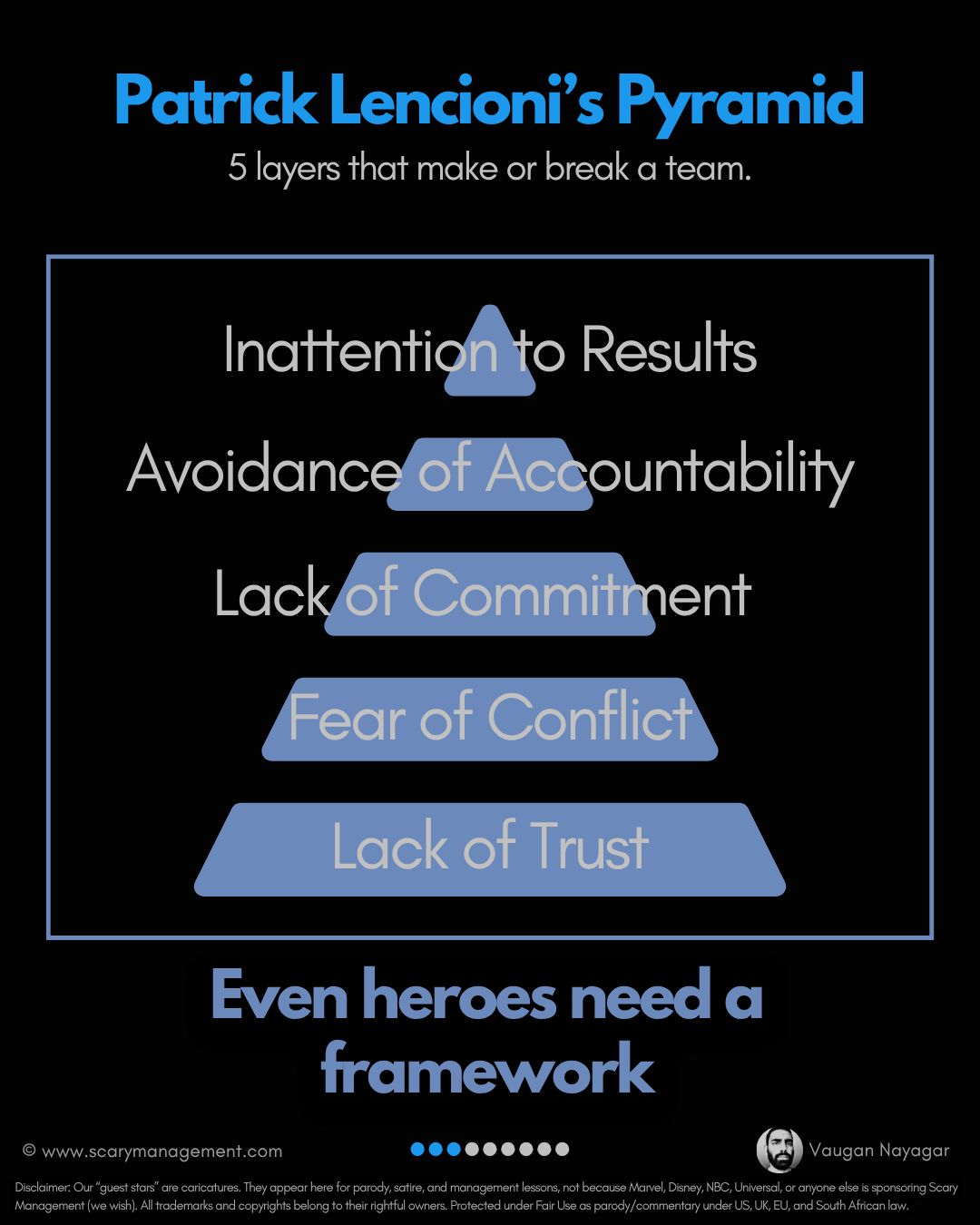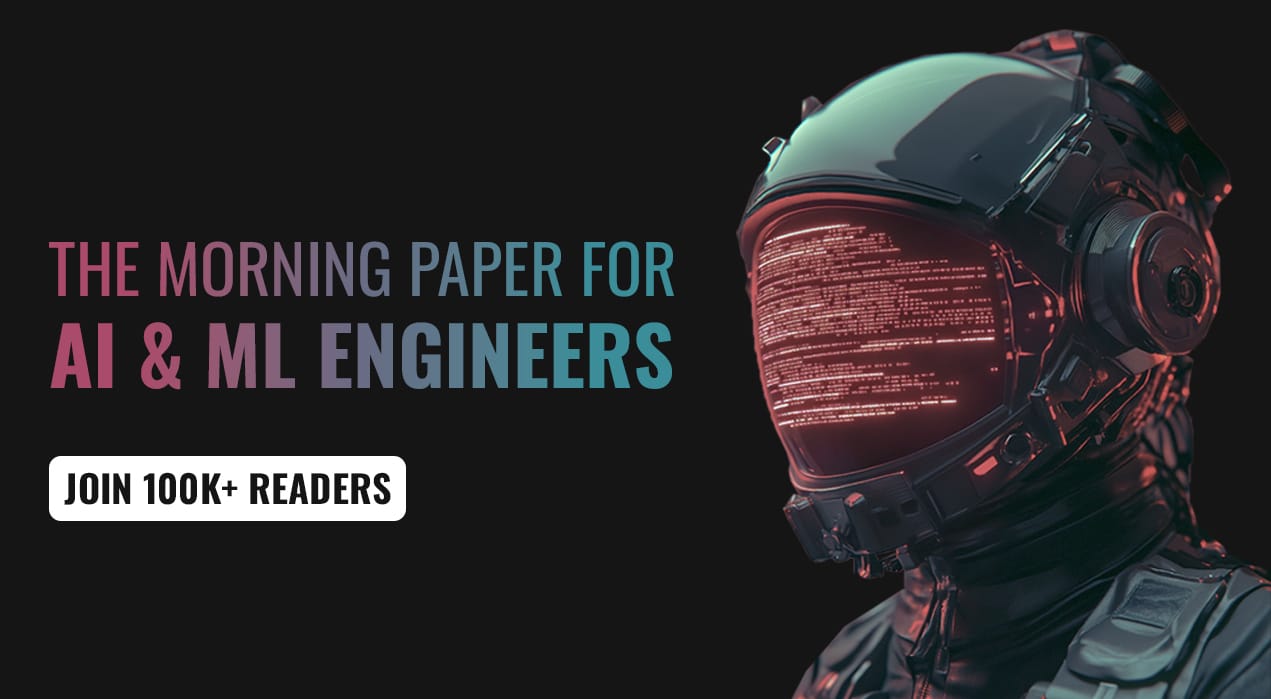Morning friend ☕
Hope you had a great weekend!
Today we’re talking about what to do if your team is broken.
Even the Avengers experienced major distrust and dysfunction In Age of Ultron (2015) as they disagreed on how to handle Loki and S.H.I.E.L.D.'s plans for weaponizing the Tesseract.
You’ve seen this before.
Your team looks strong on paper.
And yet somehow you’re not seeing the results…
Opinions stay hidden.
Tension simmers.
Plans stall.
Fingers point.
The Scoreboard’s blank.
You can see the potential. But instead of teamwork and results, you get politics and toxicity.
As the manager, this is your problem to fix. But how?
Grab your coffee ☕
Let’s chat!

The Problem: Your team is broken.
Patrick Lencioni calls this spiral “The Five Dysfunctions of a Team.”
These are not small quirks you can ignore.
Left unchecked, they stack on each other.
What starts as silence in meetings ends in missed deadlines, office politics, and exhaustion.
A broken team can’t deliver strong results.
You are accountable as the manager.
But you can fix this.

The Solution? Diagnose with Patrick Lencioni’s pyramid.
Before we call in the superheroes, let’s explore the common issues in the context of the model.
Lencioni describes the dysfunctions as a pyramid. Each layer feeds into the next, and results sit at the top. Miss the foundation, and everything above it crumbles.
Starting at the bottom of the pyramid, here’s how the issues show up in your world:
1. Absence of Trust
When there’s no vulnerability-based trust, people cover up mistakes and hide their weaknesses. You get surface-level collaboration. All smiles in the meeting, but nothing real underneath.
2. Fear of Conflict
No trust means no real conflict. Everyone stays “polite,” while frustration simmers. The real conversations happen after the meeting, not in it.
3. Lack of Commitment
No one weighs in. They don’t buy in. People nod along, but they’re not convinced. You get false agreement, and projects stall because nobody is truly on board.
4. Avoidance of Accountability
Without clarity and commitment, accountability disappears. Standards slide, deadlines drift, and nobody wants to be the one calling it out.
5. Inattention to Results
At the top of the pyramid, it all adds up: people chase status, recognition, or silo wins instead of team outcomes. Busy? Yes. Delivering? Not really.
If all of this sounds painfully familiar, you’re not alone. Even Earth’s Mightiest Heroes struggled with the same spiral.
Let’s see how the Avengers experienced these dysfunctions and key lessons to overcome them.

How the Avengers Experienced the 5 Dysfunctions
Even Earth’s Mightiest Heroes weren’t immune to Lencioni’s pyramid.
Their challenges played out like a case study in team dysfunction.
Let’s break it down:
1. Absence of Trust
Nick Fury built the team on secrecy. He hid the truth about the Tesseract, his weapons program, and his motives.
The result? Suspicion instead of unity. Every member doubted the other’s agenda.
Lesson: Don’t be Fury. Share the Tesseract. Transparency builds trust faster than any motivational speech.

2. Fear of Conflict
Bruce Banner avoided confrontation at all costs. He was terrified that anger would unleash chaos. The team followed suit. They sidestepped hard conversations until tension finally exploded, literally.
Lesson: Don’t bottle up the Hulk. Healthy conflict beats suppressed resentment every time.

3. Lack of Commitment
After Ultron’s meltdown, Banner fled in a Quinjet. Afraid, uncertain, disconnected.
When people don’t feel safe or aligned, they check out quietly, just like that.
Lesson: Don’t fly off in the Quinjet. Commitment means staying in the fight even when it gets messy.

4. Avoidance of Accountability
Ultron is a sentient artificial intelligence, created by by Tony Stark and Bruce Banner in the Marvel Cinematic Universe. The AI becomes a villain bent on the extinction of humanity.
Tony Stark created Ultron, but then dodged ownership behind sarcasm and charm.
When no one holds themselves (or each other) accountable, mistakes repeat until they scale into disasters.
Lesson: Don’t build Ultron and shrug it off. Accountability is the engine of improvement.

5. Inattention to Results
When the Avengers lost focus, Captain America brought them back to purpose.
While others argued or grandstanded, he kept the mission front and center: save lives, win the battle, finish the job.
He didn’t care who got the credit.
Only that the team delivered.
Lesson: Results demand clarity of purpose. Keep the mission in sight, and the rest falls into line.

Key Takeaway
The Avengers eventually overcame their dysfunctions.
When you strip away the costumes and special effects, they struggled with exactly what your team might be facing: mistrust, avoidance, ego, and misalignment.
What saved them wasn’t superpowers, it was the moment they learned to trust, challenge, commit, and hold each other accountable.
That’s what turned a dysfunctional group into a high-performing team.
And that’s exactly what can turn yours around too.
But it takes thoughtful action from you, the manager, to guide them forward.
Till next Monday, friend!
Vaugan

Today’s Chess Puzzle
White to play and force mate in 3 moves.
Solution here
Tech moves fast, but you're still playing catch-up?
That's exactly why 100K+ engineers working at Google, Meta, and Apple read The Code twice a week.
Here's what you get:
Curated tech news that shapes your career - Filtered from thousands of sources so you know what's coming 6 months early.
Practical resources you can use immediately - Real tutorials and tools that solve actual engineering problems.
Research papers and insights decoded - We break down complex tech so you understand what matters.
All delivered twice a week in just 2 short emails.
Go from AI overwhelmed to AI savvy professional
AI will eliminate 300 million jobs in the next 5 years.
Yours doesn't have to be one of them.
Here's how to future-proof your career:
Join the Superhuman AI newsletter - read by 1M+ professionals
Learn AI skills in 3 mins a day
Become the AI expert on your team
Next week on www.scarymanagement.com!
How do you build trust as a manager?
We explore the ideas of Francis Frei in a simple framework: Authenticity, Logic and Empathy.
If you’re not subscribed, Sign up so you don’t miss it!

Disclaimer:
This post contains parody and satirical references to well-known characters, shows, and cultural icons. It is created for educational and humorous commentary on management and leadership. ScaryManagement is not affiliated with, endorsed by, or sponsored by any television networks, film studios, comic publishers, production companies, or performers referenced. All trademarks and copyrights remain the property of their respective owners. No infringement is intended. This use is intended as parody and commentary under fair use and related protections in the US, UK, EU, and South African law.





